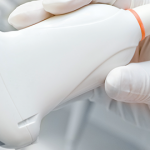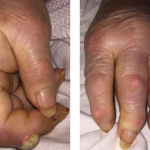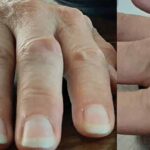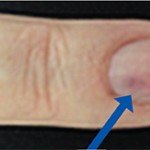Sonographic characteristics of hemangiomas can be variable. Keng et al. described sonographic findings of 43 soft tissue hemangiomas.3 Gray-scale findings of hemangiomas demonstrated that 46.5% of lesions had a well-defined margin. Hemangiomas do not have a true capsule, so the appearance of a rim or margin may be due to the difference in echotexture between the hemangioma and the surrounding tissue, as well as an acoustic interface between the lesion and surrounding tissues. Most lesions were heterogenous (86%) and hypoechoic (60.5%). In larger lesions, fluid levels and calcified phleboliths can be seen.
Doppler activity was present in 86% (37 of 43) of hemangiomas.3 A color Doppler enhancing maneuver (CDEM) can be helpful in lesions without Doppler activity. CDEM is performed by placing light compression on the mass or adjacent tissues to enhance blood flow. CDEM was performed in the six lesions without Doppler activity and four demonstrated Doppler activity after CDEM.
In Sum
Hemangiomas are one of the most common tumors of childhood. Point-of-care ultrasound is a valuable tool to better evaluate deep lesions that are difficult to diagnose by physical exam. Most lesions are heterogeneous, hypoechoic and exhibit Doppler activity, so they can be recognized and distinguished by ultrasound from other causes of soft tissue nodules encountered in the rheumatology clinic.
Clara Lin, MD, RhMSUS, is a staff pediatric rheumatologist at Children’s Hospital Colorado, Aurora. Her clinical and research interests include ultrasound in rheumatology. She is also a board member of USSONAR, a society of rheumatologists, physicians and health professionals in North America who promote the use of musculoskeletal ultrasonography to advance the care of patients with rheumatic diseases.
References
- Darrow DH, Greene AK, Mancini AJ, Nopper AJ. Section on dermatology, section on otolaryngology-head & neck surgery and section on plastic surgery. Diagnosis and management of infantile hemangioma: Executive summary. Pediatrics. 2015 Oct;136(4):786–791.
- Drapé JL, Feydy A, Guerini H, et al. Vascular lesions of the hand. Eur J Radiol. 2005 Dec;56(3):331–343.
- Keng CY, Lan HHC, Chen CCC, et al. Soft tissue hemangiomas: High-resolution grayscale and color Doppler ultrasonographic features in 43 patients. J Med Ultrasound. 2008 Dec:16(3):223–230.



